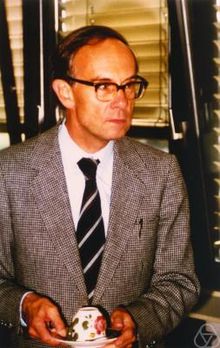Friedrich Hirzebruch
Friedrich Hirzebruch | |
|---|---|
 Friedrich Hirzebruch in 1980 (picture courtesy MFO) | |
| Born | Friedrich Ernst Peter Hirzebruch 17 October 1927 |
| Died | 27 May 2012 (aged 84) |
| Nationality | German |
| Alma mater | University of Münster ETH Zürich Institute for Advanced Study Princeton University |
| Known for | Hirzebruch-Riemann-Roch theorem |
| Awards | Wolf Prize (1988) Lobachevsky Medal (1989) |
| Scientific career | |
| Fields | Mathematics |
| Institutions | University of Bonn Max-Planck-Institut für Mathematik |
| Doctoral advisor | Heinrich Behnke Heinz Hopf |
| Doctoral students | Egbert Brieskorn Detlef Gromoll Klaus Jänich Matthias Kreck Don Bernard Zagier Lothar Göttsche |
Friedrich Ernst Peter Hirzebruch (17 October 1927[1] - 27 May 2012)[2] was a German mathematician, working in the fields of topology, complex manifolds and algebraic geometry, and a leading figure in his generation. He has been described as "the most important mathematician in the Germany of the postwar period."[3]
Biography
Hirzebruch was born in Hamm, Westphalia. He studied at the University of Münster from 1945–1950, with one year at ETH Zürich.
He then had a position at Erlangen, followed by the years 1952–54 at the Institute for Advanced Study in Princeton, New Jersey. After one year at Princeton University 1955–56, he was made a professor at the University of Bonn, where he remained, becoming director of the Max-Planck-Institut für Mathematik in 1981. More than 300 people participated in the event in ceremony of his 80th birthday at Bonn in 2007.
The Hirzebruch–Riemann–Roch theorem (1954) for complex manifolds was a major advance and quickly became part of the mainstream developments around the classical Riemann–Roch theorem; it was also a precursor of the Atiyah–Singer index theorem. Hirzebruch's book Neue topologische Methoden in der algebraischen Geometrie (1956) was a basic text for the 'new methods' of sheaf theory, in complex algebraic geometry. He went on to write the foundational papers on topological K-theory with Michael Atiyah, and collaborate with Armand Borel on the theory of characteristic classes. In his later work he provided a detailed theory of Hilbert modular surfaces, working with Don Zagier.
Hirzebruch was a foreign member of numerous academies and societies, including the United States National Academy of Sciences, the Russian Academy of Sciences, and the French Academy of Sciences. In 1980/81 he delivered the first Sackler Distinguished Lecture in Israel.
He died on 27 May 2012.[4]
Honours
Amongst many other honours, Hirzebruch was awarded a Wolf Prize in Mathematics in 1988, a Lobachevsky Medal in 1989.
The government of Japan awarded him the Order of the Sacred Treasure in 1996.[5]
Hirzebruch won an Einstein Medal in 1999, and received the Cantor medal in 2004.
See also
References
- ^ Friedrich Ernst Peter Hirzebruch, MacTutor History of Mathematics archive. Retrieved on 29 May 2012.
- ^ Max Planck Institute Announcement, Max Planck Institute for Mathematics. Retrieved on 29 May 2012.
- ^ "Friedrich Hirzebruch 1927-2012". 29 May 2012. Retrieved 29 May 2012.
- ^ "With great sadness we mourn the death of our founder, Friedrich Hirzebruch, who passed away on Sunday, May 27". Max Planck Institute for Mathematics.
- ^ L'Harmattan web site (in French), Order with gold and silver rays
- Europa Publications (2003). The International Who's Who 2004. Routledge. ISBN 978-1-85743-217-6. Retrieved 24 April 2010.
External links
- 1927 births
- 2012 deaths
- People from Hamm
- Members of the United States National Academy of Sciences
- Foreign Members of the Russian Academy of Sciences
- People from the Province of Westphalia
- German mathematicians
- Members of the French Academy of Sciences
- Foreign Members of the Royal Society
- Wolf Prize in Mathematics laureates
- Albert Einstein Medal recipients
- Knight Commanders of the Order of Merit of the Federal Republic of Germany
- Recipients of the Pour le Mérite (civil class)
- Recipients of the Order of the Sacred Treasure
- University of Münster alumni
- University of Erlangen-Nuremberg faculty
- University of Bonn faculty
